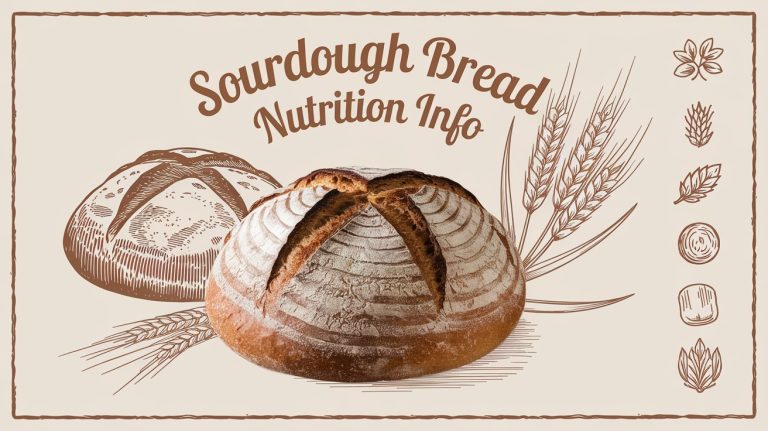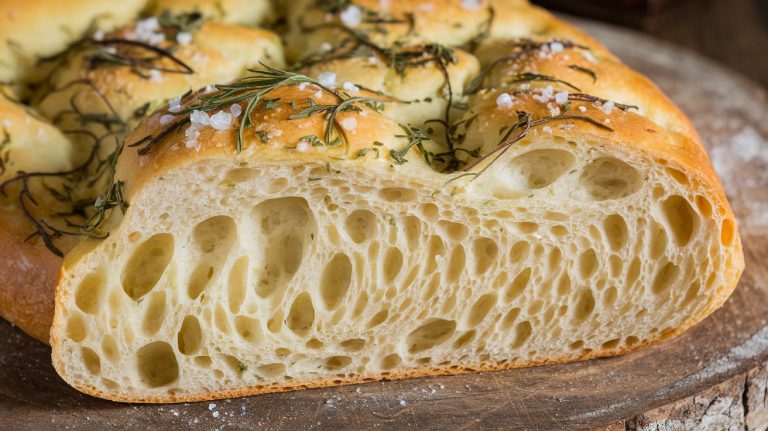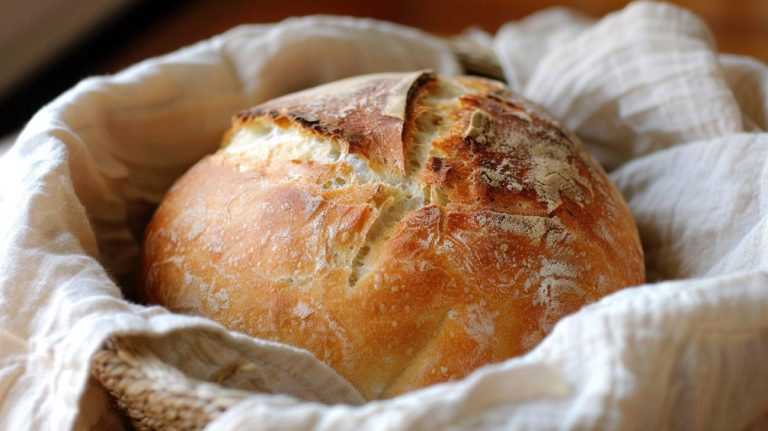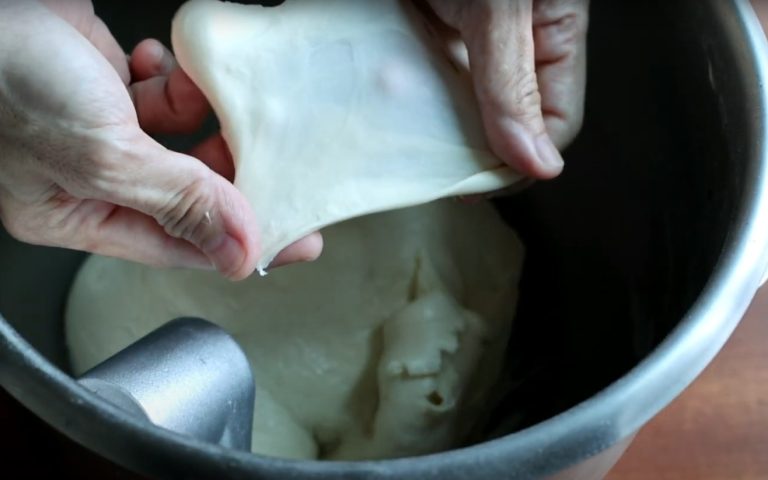Can You Make French Toast With Sourdough Bread?
You can absolutely make delicious French toast with sourdough bread, and you’ll love how its texture and tangy flavor enhance this classic dish. Stale sourdough slices soak up the custard mixture perfectly, creating a custardy interior while maintaining a crispy exterior.
To make it, whisk together eggs, milk, and spices, then soak thick slices for a couple of minutes on each side. Cook them until golden brown in a hot skillet, and consider topping them with fresh fruits and maple syrup for a delightful finish. There’s so much more to explore about this flavorful twist on a breakfast favorite.
Key Takeaways
- Yes, sourdough bread is ideal for French toast due to its sturdy texture and ability to absorb the egg mixture without falling apart.
- The tangy flavor of sourdough complements sweet toppings like maple syrup and fruits, enhancing the overall taste.
- Stale sourdough is especially effective for French toast, resulting in a custardy interior and preventing sogginess.
- Sourdough has a lower glycemic index, making it a healthier choice for French toast compared to regular bread.
Why Use Sourdough Bread?
Using sourdough bread for French toast prevents sogginess and elevates the dish with its unique tangy flavor and custardy texture.
You’ll find that stale sourdough bread works best when crafting a French toast recipe. Its sturdy structure absorbs the egg mixture without falling apart, creating a delightful, custardy interior that contrasts beautifully with the crispy exterior.
This bread’s tangy profile complements sweet toppings like maple syrup and fresh fruit, enhancing your breakfast experience.
Plus, by choosing sourdough, you’re opting for a healthier option compared to regular bread. Sourdough typically has a lower glycemic index, making it a smarter choice for your morning meal.
Another benefit is that sourdough bread is often rich in beneficial probiotics due to the fermentation process, promoting gut health.
What You Need to Make Sourdough French Toast?
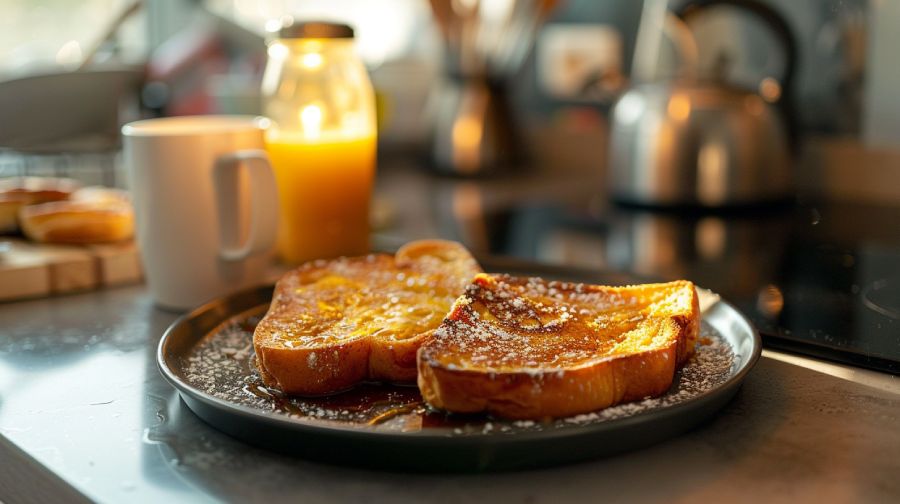
Gather a few key ingredients when you’re ready to make delicious sourdough French toast.
Stale sourdough bread, free-range eggs, and rich milk form the base of your batter, while spices like cinnamon and vanilla add that extra touch of warmth and flavor.
Let’s explore the essential components and delicious variations that will elevate your breakfast game!
Essential Ingredients Overview
To create the perfect sourdough French toast, you’ll need a few essential ingredients that elevate both the texture and flavor of this beloved dish.
Start with stale sourdough bread; its slightly dry texture allows it to soak up the egg mixture beautifully, resulting in a custardy, delicious bite. For a standard serving of four, you’ll typically use four free-range eggs, which form a rich base for your mixture.
Next, incorporate whole milk for that extra creaminess; feel free to substitute with almond or coconut milk if you prefer. A splash of high-quality vanilla extract goes a long way in enhancing the flavor profile.
To warm things up, sprinkle in some cinnamon and nutmeg, adding depth and comforting notes to your French toast.
Lastly, don’t forget about real butter. It’s essential for frying your soaked sourdough slices, ensuring that they achieve that golden finish and rich flavor.
With these ingredients, you’re well on your way to crafting a delightful breakfast that’s sure to impress!
Dairy and Egg Options
Choosing the right dairy and egg options can make all the difference in achieving a rich and flavorful sourdough French toast.
Start with high-quality free-range eggs; they not only enhance the flavor but also pack in more nutrition. A good rule of thumb is to use one egg for every 1/4 cup of milk. For that creamy texture, whole or raw milk is preferred, but if you’re looking for dairy-free alternatives, almond, coconut, or oat milk works beautifully.
Consider adding a splash of high-quality vanilla extract to elevate your custard mixture further. This simple addition can transform your French toast, bringing an inviting aroma and depth of flavor. Don’t forget to sprinkle in some spices like cinnamon and nutmeg, which not only warm up the dish but also elevate its overall taste.
If you can, opt for pasture-raised eggs. They often contain higher omega-3 fatty acids, making your French toast not just delicious but also a healthier choice.
With these thoughtful selections, your sourdough French toast will be a delightful treat that everyone will love.
Flavor Enhancements and Variations

Elevate your sourdough French toast by incorporating a variety of flavor enhancements and delicious toppings that cater to your taste preferences. With just a few simple additions, you can transform this classic dish into a gourmet experience.
Here are some great ideas to enhance the flavors:
- Spices: Add high-quality vanilla extract, along with warm spices like cinnamon and nutmeg, to your egg mixture. These spices complement the tangy taste of sourdough, creating a well-balanced dish.
- Fruits: Top your French toast with fresh fruits such as blueberries, strawberries, or bananas. They not only enhance the presentation but also provide natural sweetness and essential nutrients.
- Sweet Drizzles: Don’t forget to drizzle maple syrup or honey over your creation. This sweet contrast pairs beautifully with the sourdough, making each bite a delightful mix of flavors.
For an extra twist, consider mixing chocolate chips or nuts into the egg mixture. These additions cater to varying taste preferences and provide a delightful texture.
With these flavor enhancements and toppings, your sourdough French toast will be an irresistible breakfast or dessert option!
Step-by-Step Cooking Instructions
- Start by whisking together 4 free-range eggs,
- 1 cup of full-fat milk, 1/2 cup of double cream,
- 1 teaspoon of vanilla extract, and
- a sprinkle of cinnamon and nutmeg in a shallow dish to create a rich custard mixture.
Next, cut stale sourdough bread into thick slices, about 2.5cm (1 inch) each. Soak each slice in the egg mixture, ensuring it absorbs the custard for about 2 minutes per side.
While the bread soaks, preheat a skillet over medium heat. Melt a generous pat of real butter until it sizzles, filling the air with a delicious aroma.
Carefully place the soaked sourdough slices in the skillet, letting them cook for about 4 minutes on each side, or until they turn a beautiful golden brown.
As you finish cooking the slices, keep the cooked French toast warm in an oven set to low heat.
When all the slices are ready, serve them warm, drizzled with maple syrup or honey, and topped with fresh fruits like berries or bananas. This delightful breakfast or brunch is sure to impress!
Tips for Perfect French Toast
To make your French toast truly exceptional, you’ll want to pay attention to bread thickness, soaking time, and cooking temperature.
Thick slices of stale sourdough absorb the custard perfectly, while proper soaking guarantees every bite is flavorful without falling apart.
Keeping a close eye on the heat will help you achieve that golden-brown crust while keeping the inside delightfully soft.
Ideal Bread Thickness
Slicing your sourdough bread to a thickness of 3/4 to 1 inch is key for achieving that perfect balance of a custardy interior and a crispy exterior in your French toast. The ideal bread thickness allows the egg mixture to soak in without compromising the bread’s structural integrity during cooking.
Here are some tips to keep in mind:
- Choose Stale Sourdough: Using stale sourdough enhances texture, as it absorbs the egg mixture more effectively compared to fresh bread.
- Soaking Time: For thicker slices, aim for a soaking time of at least 10 minutes to guarantee even saturation, but don’t forget to flip them for a uniform soak.
- Cook with Care: Cook the slices on medium heat, making certain that the outside becomes crispy while the inside remains soft and custardy.
Soaking Time Guidelines
It is vital to achieve the perfect soak for your sourdough slices, as it guarantees they absorb just the right amount of egg mixture for that delicious custardy center.
For slices that are about 3/4 inch thick, aim for a soaking time of approximately 2 minutes per side. This timeframe guarantees even absorption without compromising the sturdy sourdough’s integrity. If you’re working with thicker slices, around 1 inch, extend the soaking time to 3-4 minutes. This aids in achieving that creamy texture while keeping the bread from becoming overly soggy.
It’s essential to monitor the soaking closely; over-soaking can lead to a mushy texture that detracts from your dish.
You’ll find that using stale sourdough, ideally 2-3 days old, greatly enhances the absorption process, allowing the bread to soak up more of the egg mixture while maintaining its structure. This characteristic makes sourdough far superior to softer options like brioche for French toast.
Cooking Temperature Control
Mastering the right cooking temperature is essential for transforming your soaked sourdough into perfectly golden and custardy French toast.
To achieve this, follow these key steps on cooking temperature control:
- Preheat your cast iron skillet: Start by setting your skillet to medium-high heat. This initial sear creates a crust that locks in moisture and adds flavor.
- Adjust the heat: Once you add the soaked sourdough slices, reduce the heat to medium. This allows the inside to cook thoroughly without burning the outside.
- Monitor your cooking time: Aim for about 4 minutes per side. This timeframe will help you achieve that beautiful browning while guaranteeing a custardy center without sogginess.
If your French toast starts browning too quickly, don’t hesitate to lower the heat to medium-low. This adjustment guarantees even cooking throughout the slice.
Using a cast iron skillet is highly recommended for its superior heat retention, helping you get that perfect crispy texture without overcooking.
With these tips, you’ll be well on your way to French toast perfection!
Serving Suggestions and Pairings
To elevate your Sourdough French Toast experience, pair it with vibrant fresh fruits like blueberries or strawberries for a delicious burst of flavor. These juicy additions not only brighten your plate but also provide essential nutrients, making your breakfast more satisfying.
Drizzle your warm, golden-brown French toast with rich maple syrup or honey to enhance its sweetness, creating a perfect balance of flavors. If you want to take it up a notch, a light dusting of powdered sugar can transform your dish into a dessert-like treat.
For an indulgent twist, why not serve your Sourdough French Toast with a scoop of creamy vanilla ice cream? This delightful combination can easily turn your breakfast into a special occasion.
To add some texture, sprinkle chopped nuts or granola on top for a satisfying crunch that complements the soft, fluffy toast. If you’re in the mood for something savory, crispy bacon or sausage can harmonize beautifully with the sweetness, giving you a hearty breakfast that hits all the right notes.
Enjoy experimenting with these serving suggestions to find your perfect pairing!
Variations on the Recipe
Discover the delightful world of Sourdough French Toast variations that can transform your breakfast into a culinary adventure, featuring unique flavors and textures that cater to every palate.
With just a few tweaks, you can elevate your sourdough French toast experience. Here are some scrumptious variations to try:
- Mascarpone Stuffed Sourdough French Toast Casserole: This decadent twist incorporates creamy mascarpone filling, giving each bite a rich and luxurious texture.
- Spiced Batter: Instead of the usual cinnamon, experiment with spices like cardamom or nutmeg for a unique flavor profile that surprises your taste buds.
- Fruity Compote Topping: Top your French toast with a seasonal fruit compote—think strawberries or blueberries—to add a burst of sweetness and freshness.
Don’t forget about the toppings! You can sprinkle chocolate chips or nuts for extra crunch and flavor.
Each variation brings a new dimension to the classic dish, making your sourdough French toast not just a meal, but an exciting culinary experience you’ll want to repeat again and again.
Nutritional Information
Sourdough French Toast offers a delicious balance of flavors and nutrients, making it a satisfying choice for your morning meal. Each serving contains approximately 307 calories, providing an enjoyable yet balanced option for breakfast or brunch. With 47 grams of carbohydrates, it serves as a great energy source, especially when paired with fresh fruits or a drizzle of syrup.
You’ll appreciate the 12 grams of protein per serving, which helps with muscle repair and keeps you feeling full throughout the morning. Additionally, the dish has 8 grams of fat, including 4 grams of saturated fat. If you’re conscious about fat intake, consider using cooking alternatives or adjusting your portion sizes to fit your dietary needs.
Each bite not only delights your taste buds but also enriches your body with essential vitamins and minerals like calcium and iron, enhancing its nutritional profile. So, when you whip up a plate of Sourdough French Toast, you’re indulging in a meal that’s not just tasty but also packed with beneficial nutrients to kick start your day right!
Common Cooking Challenges
Cooking the perfect Sourdough French Toast can present a few common challenges that, if addressed, will elevate your breakfast experience. Here are three key issues to watch for:
- Egg-to-Milk Ratio: If your French toast turns out too eggy, adjust the egg-to-milk ratio to 1 egg per 1/4 cup of milk. This balance enhances flavor without overwhelming the dish.
- Soaking Times: When using thick slices of sourdough, be prepared for longer soaking times. Make sure the bread absorbs the custard mixture without becoming overly soggy. A proper soak guarantees each bite is flavorful and moist.
- Uneven Cooking: Sourdough can sometimes cook unevenly. Pay attention to your skillet’s heat level, adjusting as necessary to achieve a consistent golden brown finish on both sides. Preheating the skillet properly and using just enough butter helps avoid a greasy texture.
Frequently Asked Questions
What Bread Is Good for French Toast?
For French toast, choose thick slices of brioche or Challah for richness, or stick with sturdy sourdough to prevent sogginess. Whole grain adds heartiness, but avoid overly dry breads that won’t absorb the egg mixture well.
Does Sourdough Bread Make Nice Toast?
Imagine golden slices crisping to perfection as the warm aroma of toasted sourdough fills your kitchen. You’ll love how its sturdy structure creates a satisfying crunch, making each bite a delightful experience that’s hard to resist.
Is Sourdough or Brioche Better for French Toast?
When choosing between sourdough and brioche for French toast, you’ll find sourdough’s tangy flavor and sturdy texture prevent sogginess, while brioche’s softness can lead to mushiness. Sourdough’s health benefits make it the better choice overall.
What Should We Avoid When Making French Toast?
When making French toast, avoid using fresh bread, over-soaking, low-quality eggs, and high cooking temperatures. Instead, opt for stale slices, soak briefly, and cook on medium heat for perfectly fluffy, delicious results.
Creative Breakfast Delights: Turning Sourdough into Irresistible French Toast
Incorporating sourdough bread into your French toast recipe is like adding a splash of sunshine to your morning routine.
The tangy flavor and chewy texture elevate this classic dish to new heights.
With just a few simple ingredients and a bit of creativity, you can create a breakfast that’s not only delicious but also satisfying.
So, next time you’re in the mood for a cozy brunch, reach for that sourdough and savor every bite.
Enjoy!



